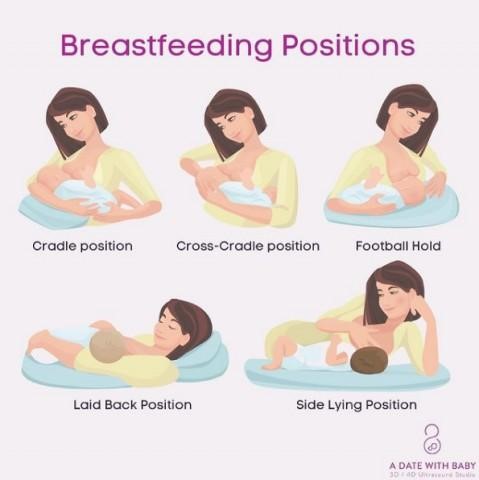A nurse is caring for a postpartum client who had a cesarean section and is breastfeeding her newborn.
The nurse notices that the client is holding her newborn in a football hold position.
What is an appropriate response by the nurse?
Praise the client for choosing a suitable position for breastfeeding.
Advise the client to change to a cradle hold position for better latch.
Remind the client to support her breast with her hand during feeding.
Ask the client if she is experiencing any pain or discomfort in her incision.
The Correct Answer is A
Praise the client for choosing a suitable position for breastfeeding. The football hold is a common and comfortable breastfeeding position that allows the mother to support the baby’s head and help with latching. It is especially good for mothers who had a cesarean section, have large breasts, or are breastfeeding twins.
Choice B is wrong because there is no need to change to a cradle hold position if the mother and baby are comfortable with the football hold.
Different positions may work better for different mothers and babies.
Choice C is wrong because the mother does not need to support her breast with her hand during feeding.
This may interfere with the baby’s latch and cause nipple soreness.
Choice D is wrong because asking the client if she is experiencing pain or discomfort in her incision may imply that she is doing something wrong by holding her baby in that position.
It may also make the mother feel anxious or guilty about her pain.
The nurse should assess the incision site regularly and provide pain relief as needed, but not question the mother’s choice of breastfeeding position.

Nursing Test Bank
Naxlex Comprehensive Predictor Exams
Related Questions
Correct Answer is ["A","C","D","E"]
Explanation
The correct answer is choice A, C, D, and E. Here is why:
• Choice A is correct because colostrum is thick, yellowish, and high in protein, vitamins, minerals, immune cells, and immunoglobulins.Immunoglobulins are antibodies that provide passive immunity to the newborn.
• Choice B is wrong because it describes the characteristics of mature milk, not colostrum.Mature milk is thin, whiter, and higher in fat, carbohydrates, lactose, water, vitamins, immunoglobulins, and growth factors.
• Choice C is correct because colostrum protects the infant’s gastrointestinal tract from infections and helps establish normal flora.Normal flora are beneficial bacteria that aid in digestion and immunity.
• Choice D is correct because colostrum has a laxative effect that helps clear meconium and prevent jaundice.Meconium is the first stool of the newborn, which contains waste products from the fetal life.Jaundice is a yellowing of the skin and eyes caused by excess bilirubin, a breakdown product of red blood cells.
• Choice E is correct because colostrum meets all the nutritional needs of the newborn during the first few days of life.Colostrum is rich in calories and nutrients and provides adequate hydration to the newborn.
Correct Answer is ["A","B","E"]
Explanation
The correct answer is choice A, B and E.These foods are good sources of protein, calcium, iron, folate, vitamin B12, vitamin D, iodine, selenium, zinc, omega-3 fatty acids, and antioxidants that are essential for milk production and quality.
Choice C is wrong because coffee, tea, soda, energy drinks, chocolate, and alcohol are not nutritious foods and can have negative effects on the mother and the baby.They can cause dehydration, irritability, insomnia, poor weight gain, and fetal alcohol syndrome.
Choice D is wrong because whole grains, fruits, vegetables, vegetable oils, and herbs are not sufficient to provide all the nutrients needed by the mother and the baby.They are good sources of carbohydrates, fiber, vitamin C, vitamin E, and phytochemicals, but they lack protein, calcium, iron, folate, vitamin B12, vitamin D, iodine, selenium, and zinc.
The normal ranges for these nutrients are:
• Protein: 71 g/day for lactating women
• Calcium: 1000 mg/day for lactating women
• Iron: 9 mg/day for lactating women
• Folate: 500 mcg/day for lactating women
• Vitamin B12: 2.8 mcg/day for lactating women
• Vitamin D: 15 mcg/day for lactating women
• Iodine: 290 mcg/day for lactating women
• Selenium: 70 mcg/day for lactating women
• Zinc: 12 mg/day for lactating women
• Omega-3 fatty acids: 1.3 g/day for lactating women
• Antioxidants: no specific recommendation but fruits and vegetables are good sources
Whether you are a student looking to ace your exams or a practicing nurse seeking to enhance your expertise , our nursing education contents will empower you with the confidence and competence to make a difference in the lives of patients and become a respected leader in the healthcare field.
Visit Naxlex, invest in your future and unlock endless possibilities with our unparalleled nursing education contents today
Report Wrong Answer on the Current Question
Do you disagree with the answer? If yes, what is your expected answer? Explain.
Kindly be descriptive with the issue you are facing.
